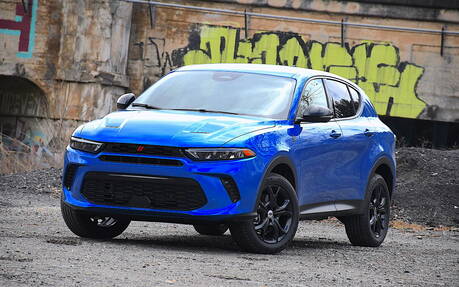2023 Dodge Hornet : New Blood, But at What Price?
The Dodge lineup basically consists of three models: the Charger sedan, the Challenger coupe and the Durango SUV. That's a bit thin, admittedly. What's worse, at the end of 2023, two iconic models will be retired (the Charger and Challenger), while we'll be saying goodbye to the V8 Hellcat engine in order to start the electric shift.
This shift will take shape with the arrival of a new model in 2024, but it starts this year with the Hornet SUV, the first partially electrified vehicle of the brand's history. What about the product? Let's just say it's true to the Dodge brand, even if, ironically, its origins are Italian. In fact, it's an Americanized version of the Alfa Romeo Tonale, which is also making its debut this year.
- Also: 2023 Dodge Hornet Pricing Details Announced for Canada
- Also: 2023 Dodge Hornet: A New PHEV Crossover is Born
The presentation and first drive of the Hornet took place in North Carolina. Here's what we learned about the first all-new Dodge model since the Dart in 2013.
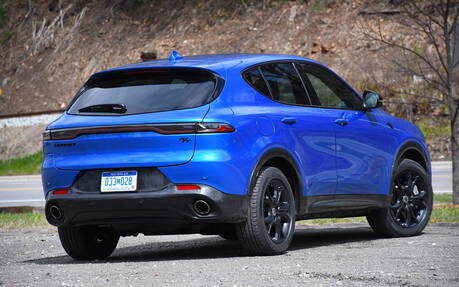
Two Hornets
Dodge will market two versions of its Hornet, the GT and R/T. The first is a gas-only model and is powered by a 2.0-liter turbocharged 4-cylinder engine (268 horsepower and 295 lb-ft of torque). The second uses plug-in hybrid technology and is powered by a 1.3-litre turbocharged 4-cylinder engine paired with electric motors. This electrified version promises 50 kilometres of range thanks to a 15.5 kWh battery.
Both models provide plenty of power; Dodge is sticking to its DNA and is setting itself apart with the most unbridled offerings in the subcompact/compact SUV category (the Hornet's size puts it somewhere in between). All-wheel drive also comes standard on all models. As for the automatic transmissions, the one paired with the 2.0-liter engine has nine gears, while the one coupled with the 1.3-liter engine has only six.
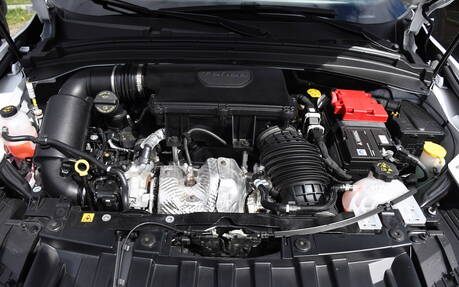
A World of Choices
While only two models appear in the catalogue, the reality is more complex. All in all, Dodge offers a total of 44 possible combinations, including variants and option packages. The GT version is priced at $37,995 (before $2,095 transport and preparation fees). Its equipment level remains generous, but incomplete. For example, it includes wireless Apple CarPlay and Android Auto apps, passive keyless access, dual-zone climate control, and 12.3- and 10.25-inch displays for the instrument cluster and Uconnect5 multimedia system, respectively.

However, you have to opt for the Cold Weather package to enjoy remote start, heated front seats and steering wheel. This $995 option is too much for a base model at this price level. Fortunately, these features come standard with the GT Plus variant, which costs $43,995. This trim level comes with leather upholstery, heated and ventilated front seats, a sunroof, a 14-speaker Harman Kardon audio system, a power liftgate, and wireless navigation and charging for mobile devices.
Moving up to the R/T model, which is priced at $50,495, you get the Cool Climate Package, an auto-dimming rearview mirror, integrated garage door opener, Brembo brakes, and 18-inch aluminum wheels. The suggested price is $55,995, and with all models, three packages are available ranging between $1,595 and $3,795 depending on the model. These are the Blacktop (which adds black accents), Track Pack (Alcantara-covered sport seats, Brembo brakes, 20-inch aluminum wheels, interior accents and aluminum pedals), and Tech Pack (which adds a set of driving aids). In short, you can design a Hornet that suits your tastes and preferences.
The only good news is that both R/T variants are eligible for rebates from both levels of government, so after adding taxes, you can take $10,000 out of the equation. But even then, the Hornet is still the most expensive model in its class.
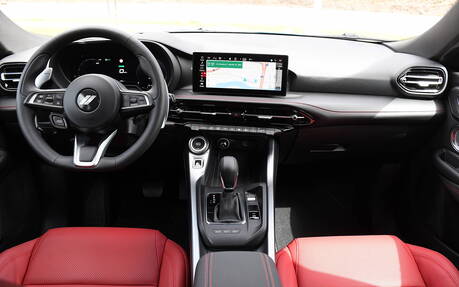
Dynamic Driving
We had the opportunity to drive both versions of the Hornet in North Carolina. But the drive was too short to come up with any solid conclusions, especially considering that our first impressions point in several directions. The Dodge DNA is very much in evidence, and the performance is clearly up to par. You've seen the power figures…
The R/T variant even features a Powershot mode that delivers an extra 30 horsepower for 20 seconds (on a full charge) and instant torque, if needed. This variant offers a series of drive modes (hybrid, electric and E-Save) that allow you to manage full-electric range. Otherwise, both versions deliver a driving experience that puts the driver in the centre of the action. The Hornet is very responsive, thanks to a well-built rigid chassis and a sport-tuned suspension. Let's just say that Hornets should be seen more in the left lane than the right. The nine-speed transmission was hesitant at times, especially at low speeds and during stop and go. Ironically, the GT variant is more pleasant overall, even if it's a little less powerful - the 1.3-liter engine lacks flexibility.

In short, we'll need more time behind the wheel to come to more complete and accurate conclusions.
Design
Styling is subjective, but here’s our take on it. Let's just say that the rear portion has cleaner lines than the front, which sticks to the brand’s design language. The similarities with the Alfa Romeo Tonale are there, but the two SUVs are easily distinguishable, thanks to the Italian manufacturer's singular approach - the Hornet will also be assembled in Italy. The materials used are of good quality, but the assembly looks so-so. Time will tell how everything holds together in the cabin.
As for the space, whether it's the clearance, the rear seats or the cargo volume (1,550 litres at the most), it's decent, but nothing more. That said, it may not be a determining factor for typical Hornet buyers. They’ll mostly be attracted by its performance or PHEV capabilities.
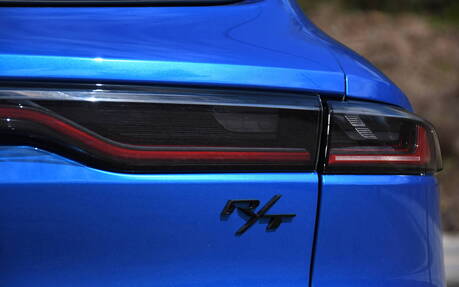
Conclusion
With the arrival of the Hornet, Dodge will be in the spotlight for other reasons than its muscle cars. And that’s a good thing. However, this newcomer comes with a hefty price tag. It’s an interesting product nonetheless, so let's give it a chance for now.
WATCH: 2023 Alfa Romeo Tonale First Images
| Test drive report | |
| Test model | 2023 Dodge Hornet |
|---|---|
| Trim level | R/T PHEV |
| Price range | $37,995 – $54,000 |
| Price as tested | 54 000 $ |
| Warranty (basic) | 3 years/60,000 km |
| Warranty (powertrain) | 5 years/100,000 km |
| Fuel economy (city/highway/observed) | N/A |
| Options | N/A |
| Competitive models | Chevrolet Equinox, Ford Bronco Sport, Ford Escape, GMC Terrain, Honda CR-V, Hyundai Tucson, Jeep Cherokee, Jeep Compass, Kia Sportage, Mazda CX-5, Mazda CX-50, Mitsubishi Outlander, Nissan Rogue, Subaru Forester, Toyota RAV4, Volkswagen Tiguan |
| Strong points |
|
| Weak points |
|
| Editor's rating | |
| Fuel economy | The R/T hybrid is efficient with an average of 5 L/100 km. |
| Comfort | Seating is good. But the Hornet compromises on ride comfort to deliver a more dynamic drive. Also, large/tall passenger could find the cabin cramped. |
| Performance | With powerful engines, the Hornet sets the tone in the category. |
| Infotainment | The Uconnect5 system isn't intuitive in all applications at Stellantis. But it turned out to be great in the Hornet. |
| Driving | Good overall experience. But with a few hiccups; namely with the finicky 9-speed transmission and occasionaly numb steering. |
| Overall | The Hornet had many good sides. But its pricing structure could discourage buyers. |
